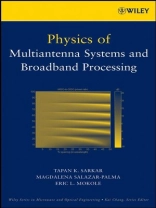An analysis of the physics of multiantenna systems
Multiple-Input Multiple-Output (MIMO) technology is one of the
current hot topics in emerging wireless technologies. This book
fills the important need for an authoritative reference on the
merits of MIMO systems based on physics and provides a sound
theoretical basis for its practical implementation. The book also
addresses the important issues related to broadband adaptive
processing.
Written by three internationally known researchers, Physics of
Multiantenna Systems and Broadband Processing:
* Provides a thorough discussion of the physical and mathematical
principles involved in MIMO and adaptive systems
* Examines the electromagnetic framework of wireless
communications systems
* Uses Maxwell’s theory to provide a system-based framework for
the abstract concept of channel capacity
* Performs various numerical simulations to observe how a typical
system will behave in practice
* Provides a mathematical formulation for broadband adaptive
processing and direction-of-arrival estimation using real antenna
arrays
* Integrates signal processing and electromagnetics to address the
performance of realistic multiantenna systems
With Physics of Multiantenna Systems and Broadband Processing,
communication systems engineers, graduate students, researchers,
and developers will gain a thorough, scientific understanding of
this important new technology.
Innehållsförteckning
Preface.
Acknowledgments.
Chapter 1. What is an Antenna and How Does it Work?
Chapter 2. Fundamentals of Antenna Theory in the Frequency
Domain.
Chapter 3. Fundamentals of an Antenna in the Time Domain.
Chapter 4. A Look at the Concept of Channel Capacity from a
Maxwellian Viewpoint.
Chapter 5. Multiple-Input-Multiple-Output (MIMO) Antenna
Systems.
Chapter 6. Use of the Output Energy Filter in Multiantenna
Systems for Adaptive Estimation.
Chapter 7. Minimum Norm Property for the Sum of the Adaptive
Weights in Adaptive or in Space-Time Processing.
Chapter 8. Using Real Weights in Adaptive and Space-Time
Processing.
Chapter 9. Phase-Only Adaptive and Space-Time Processing.
Chapter 10. Simultaneous Multiple Adaptive Beamforming.
Chapter 11. Performance Comparison Between Statistical-Based and
Direct Data Domain Least Squares Space-Time Adaptive Processing
Algorithms.
Chapter 12. Approximate Compensation for Mutual Coupling Using
the In Situ Antenna Element Patterns.
Chapter 13. Signal Enhancement Through Polarization Adaptivity
on Transmit in a Near-Field MIMO Environment.
Chapter 14. Direction of Arrival Estimation by Exploiting
Unitary Transform in the Matrix Pencil Method and its Comparison
with ESPRIT.
Chapter 15. DOA Estimation Using Electrically Small Matched
Dipole Antennas and the Associated Cramer-Rao
Bound.
Chapter 16. Non-Conventional Least Squares Optimization for DOA
Estimation Using Arbitrary-Shaped Antenna Arrays.
Chapter 17. Broadband Direction of Arrival Estimations Using the
Matrix Pencil Method.
Chapter 18. Adaptive Processing of Broadband Signals.
Chapter 19. Effect of Random Antenna Position Errors on A Direct
Data Domain Least Squares Approach for Space-Time Adaptive
Processing.
Index.
Om författaren
Tapan K. Sarkar, Ph D, is a Professor in the Department of
Electrical and Computer Engineering at Syracuse University, New
York. His current research interests deal with numerical solutions
of operator equations arising in electromagnetics and signal
processing with application to system design. He is the author or
coauthor of several books, including Smart Antennas and History of
Wireless, both published by Wiley.
Magdalena Salazar-Palma, Ph D, is a Professor in the Departamento
de Teoría de la Señal y Comunicaciones at Universidad
Carlos III de Madrid (Spain). She has authored several books,
including Smart Antennas and History of Wireless, and more than 280
publications in books, scientific journals, and symposium
proceedings.
Eric L. Mokole, Ph D, is the Acting Superintendent of the Radar
Division of the Naval Research Laboratory (NRL) in Washington, D.C.
He has published more than sixty conference publications, journal
articles, book chapters, and reports and is the lead editor of
Ultra-Wideband, Short-Pulse Electromagnetics 6 and coeditor of
Ultra-Wideband, Short-Pulse Electromagnetics 7.












